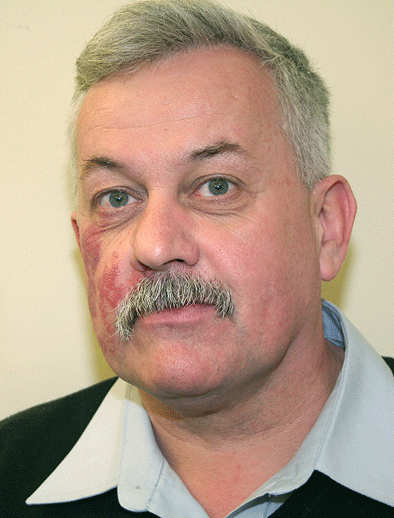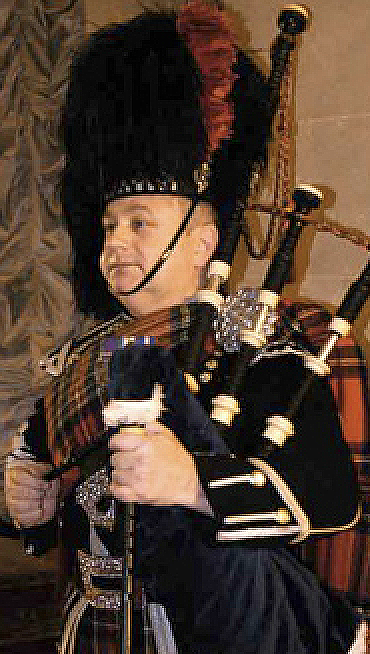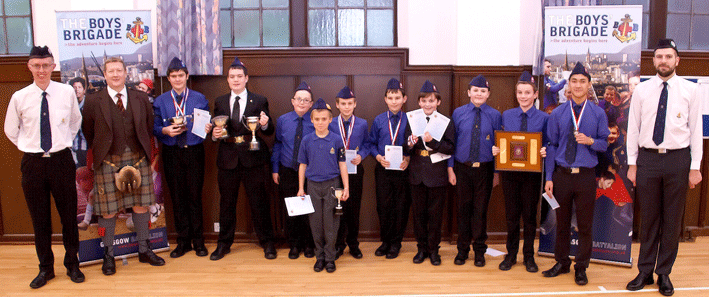
My report the other day on P/M Peter MacInnes and his tune for Captain John Young brought to mind Peter’s own heroism and that of his piper colleagues in the 2nd Battalion Scots Guards during the 1982 Falklands War. Many youngsters now learn the tune Crags of Tumbledown Mountain by P/M James Riddell, Scots Guards, but how many know the story behind the tune? The picture above was taken on top of the mountain on a bitterly cold day in 2007 when 250 veterans made the 8,000 mile journey to the Falkland Islands to honour their fallen comrades, those who didn’t make it home 25 years previously, 15 Scots Guardsmen in all.
Peter, his piper comrades Steven Duffy and Ian Davidson played on the mountain top, at memorial services, and at less formal social events in the islands’ capital Port Stanley. It was, they said, ‘A humbling and emotional experience. Playing on Tumbledown Mountain in a blizzard was no picnic but a lot easier than 25 years ago.’ Listen to the tune played here by the Pipes and Drums and military band of the SG 2nd Battalion, and check out the pictures of the terrain.

Pipers were part of the medical orderly unit involved in a night attack on the Argentine positions on the mountain. The date was July 14, 1982. Peter was medical orderly to a diversionary force (see below). Several men were killed and wounded by concentrated machine gun fire and the force later came under heavy fire from mortars and artillery. Throughout the bombardment Peter went forward to tend the wounded and give morphine with complete disregard for his own safety. On withdrawal he ensured the wounded reached a safe area. Steven was also involved in the diversionary attack and crawled forward under fire to take an anti-tank weapon from an injured NCO. On discovering it was out of action he crawled on to another wounded man, took his machine gun, and brought effective fire on the enemy. The guardsmen were under constant bombardment throughout and Steven and his Commanding Officer provided covering fire until ordered to withdraw. Both received multiple wounds but arrived safely back at the unit’s rendezvous point. Both Peter and Steven were Mentioned in Dispatches for their bravery. An official record of the Battle for Tumbledown Mountain gives one a taste of what they had to endure: ‘The diversionary attack along the Stanley track went in as planned by a small assault group led by the light tanks. Reaching the enemy positions, one of the Guards and a Royal Engineer were killed in a fire-fight that lasted for two hours, and more were wounded withdrawing through a minefield, but the diversion did its job. By now, in phase one, G Coy had crossed the start line with 7 Platoon and Coy HQ occupying the first half of their objective and 8 and 9 Platoons the second half. Securing the western end by 10.30 pm, the positions were used to support LF Coy who came through to face heavy fire from snipers and GPMG’s.

In this second phase, LF Coy’s 13 Platoon fought for the high crags on the left and 15 Platoon lower down on the right, while 14 Platoon followed in reserve with Coy HQ. As they pushed forward under increasing mortar and artillery bombardment, two men were killed and a third mortally wounded by snipers. Anti-armour weapons were only partially successful against the Argentine bunkers, but 13 Platoon made some progress with grenades. However, only after three hours, at 2.30 am, could artillery fire be brought down on the enemy positions in front of the stalled 15 Platoon, who with Coy HQ were now able to attack forward and up, overcoming the defences in often hand-to-hand fighting. Eventually, and after a seven hour struggle, just a few men of LF Coy reached the summit.
Now in phase three, RF Coy was able to come up, although the battle was far from over. With 3 Platoon giving covering fire, Number 1 and Lt Lawrence’s 3 Platoon continued the assault on the eastern end, again using the MAW’s and LAW’s, but also moving forward in small groups taking positions with grenades and bayonets. Eventually around 8.15 am and well after dawn, Tumbledown was in the Scots Guard’s hands after fighting probably the best Argentine unit, and losing eight men killed and the Royal Engineer.’

Latest BB contest results – Bryan Sinclair reports: ‘Saturday 21st November saw the return of the annual Glasgow Battalion Boys’ Brigade chanter and solo piping competitions. This year the contest was held at St. John’s Renfield Church, home of the 5th Glasgow Company. There was a healthy number of entries and the standard continues to increase year on year. A special thanks goes to P/Sgt Kurt Mackintosh (Glasgow Skye Association PB) who was tasked with adjudicating on the day.
‘The next event in the Battalion’s musical calendar is the annual mini and full band contests on Saturday 20th February 2016 at Ibrox Parish Church. For further information please contact Bryan Sinclair, Music Panel Convenor, at: musicpanel@bbglasgow.org.uk‘
Chanter Contest:
1 Ian McDonach 128th Glasgow
2 Euan Coyle 128th Glasgow
3 Andrew Dale 231st Glasgow
Junior Section Contest:
1st Alexander Bell 5th Glasgow
Intermediate Solo Piping Contest
1 Connor Black 231st Glasgow
2 Andrew Bell 5th Glasgow
3 Scott McCormick 145th Glasgow
Senior Solo Piping Contest
1 Scott McPherson 145th Glasgow
2 Ian Cheng 128th Glasgow
Open Solo Piping Contest
1 Connor Black 231st Glasgow
2 Andrew Bell 5th Glasgow
3 Scott McPherson 145th Glasgow
Reports are reaching us that there are to be major cuts in the provision of music teaching in Edinburgh Schools. The Musician’s Union is mounting a campaign against the decision. I don’t know to what extent piping will be affected, but it makes the work being done by Angus Tulloch and David Johnston and their Scottish Schools Pipe Band Trust all the more vital. This appeared in yesterday’s Scotsman newspaper: ‘The Scottish Schools Pipes and Drums Trust (SSPDT) works with more than 1000 aspiring musicians in 14 projects across 11 local authority areas. It started out as an East Lothian-based group before rebranding itself in April to reflect its nationwide activities.
‘It is impossible to overestimate the impact that piping and drumming has had in Preston Lodge in recent years,’ said head teacher Gavin Clark. ‘The Preston Lodge Pipe Band has grown quickly from a tentative group of new players into the flourishing figurehead of our school and its community. Young people of all ages and abilities, have benefited immeasurably from the skill development and self-esteem building that piping and drumming can provide.'[wds id=”19″]
‘The bagpipe is Scotland’s national instrument yet most pupils in state schools are not offered the chance to learn the pipes or Highland drumming on a par with other instruments,’ continued Johnston. ‘In Glasgow, you can learn glockenspiel or an alpine horn but you can’t learn the bagpipes. We have a project at Banff Academy with 120 kids learning pipes and drums, which is more in-school tuition than Glasgow and Edinburgh combined, a figure which I think a lot of people find quite shocking.’
[wds id=”3″]
















I really like this article as I have worked with Peter and he is a great man and mentor to the children which he passed on his piping knowledge little did I know about this history. Love the tune crags of tumbledown. superb thanks for sharing this
Robert,
Re situation in Edinburgh – In so far as Pipe and Drum tuition within Edinburgh schools is concerned the Local Authority input is negligible. There are a couple of initiatives ongoing which involves partnership arrangements with money sourced out with the LA budget.
Interestingly – the proposal is for instrumental tuition fees to be funded by parents, ironically this may help establish pipe and drum tuition within schools as whilst children currently have access to other instruments they do not for pipe and drum tuition. Would they now do so if the proposal goes ahead?. This issue has been and continues to be shameful for the Capital City and indeed those elected members who preside over such matters.
Barry Donaldson